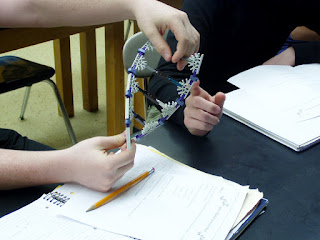 |
| Adding more sugar phosphate bonds to link our DNA |

 |
| Period 2's "classroom DNA" |
 Today we started working with the Kinex DNA models. I gave you a bit of freedom in determining the DNA sequence, and we then made one big DNA molecule.
Today we started working with the Kinex DNA models. I gave you a bit of freedom in determining the DNA sequence, and we then made one big DNA molecule.  |
| Only In Miss E's Room would you find boxes of DNA |
 |
| Piecing it together |





 What does this MEAN then? That two dwarfs that are Heterozygous have a 25% chance of having an averaged sized child. Those of you who have followed Little People Big world can now see how this couple could have 2 children that were averaged size. What does that mean about THEIR genotypes?!?! They MUST be heterozygous. So EVERY time they have children, there is a 25% chance they will be average sized.
What does this MEAN then? That two dwarfs that are Heterozygous have a 25% chance of having an averaged sized child. Those of you who have followed Little People Big world can now see how this couple could have 2 children that were averaged size. What does that mean about THEIR genotypes?!?! They MUST be heterozygous. So EVERY time they have children, there is a 25% chance they will be average sized.


*If someone exhibits a dominant phenotype – what are the possible genotypes they could be? Homozygous Dominant (TT) or Heterozygous (Tt) - Remember - a recessive allele can be present but is not expressed when a dominant allele is paired with it.
*If someone exhibits the recessive phenotype, what are the possible genotypes they could be? Homozygous Recessive (tt) - there is only ONE possible outcome to this. The ONLY way a recessive phenotype is expressed is if there are ONLY recessive alleles for that trait.
*True or False: Dominant traits are more common in a population. VERY VERY FALSE!!! Dominant only means that it is expressed if present- NOT that it is more common OR that it is "better" (For instance - the allele for having 6 fingers is dominant over having 5 fingers......)
After the daily questions we continued through notes focusing on predicting genotypes based on phenotypes. One trait we looked at was the presence or absence of a widows peak..
Homologous chromosomes each have different forms of a gene on them (one from your mom and one from your dad) These different “forms” are known as Alleles.
These can either be dominant or recessive. Those that are recessive are Hidden if a dominant allele is present.
The two alleles an organism has for a specific trait is known as its Genotype. The actual characteristic that it has (the Physical appearance is known as its Phenotype